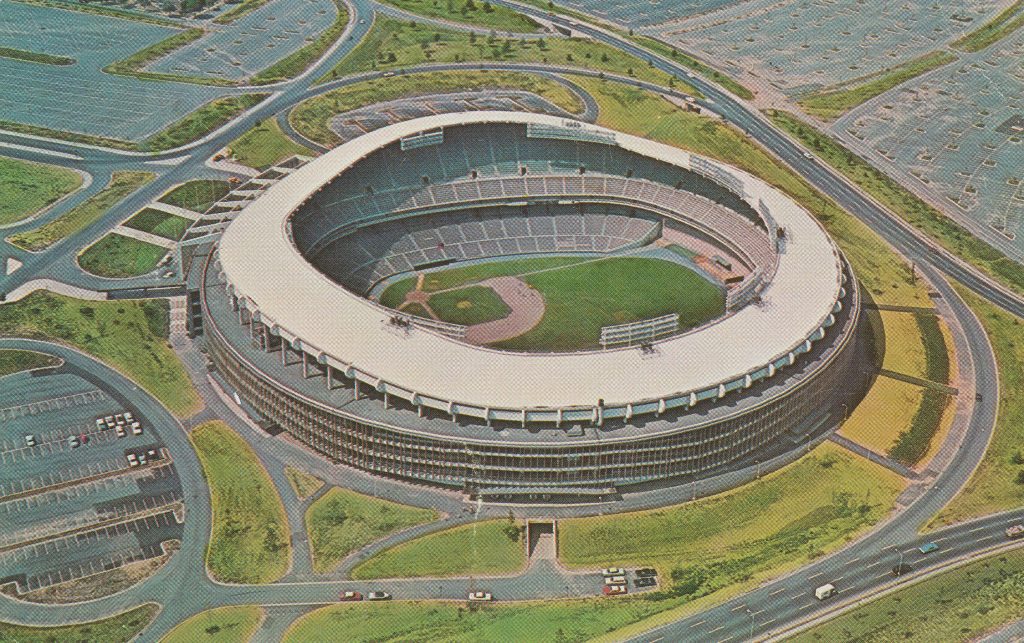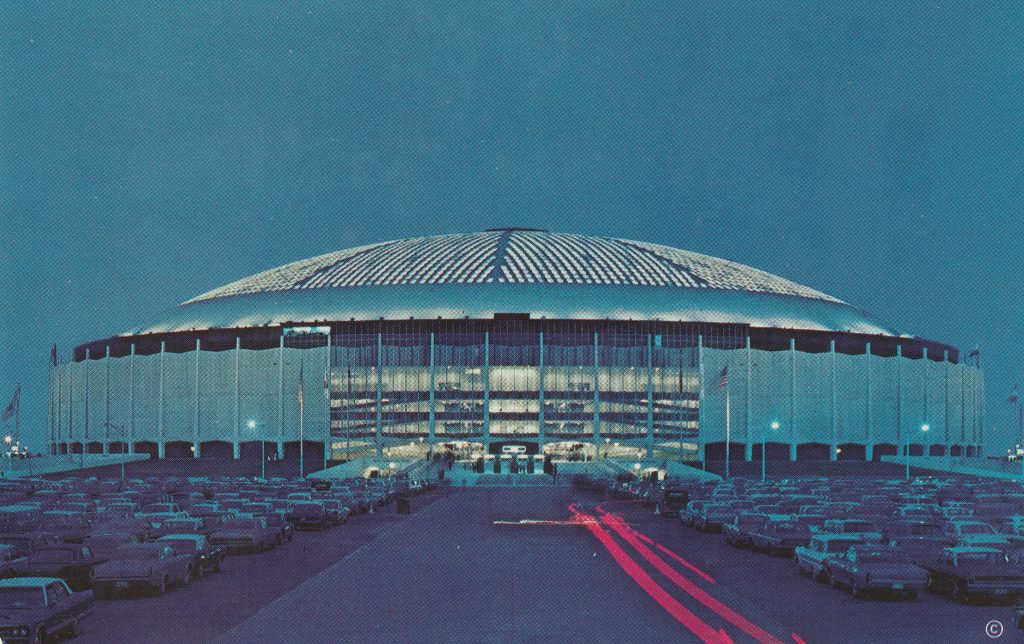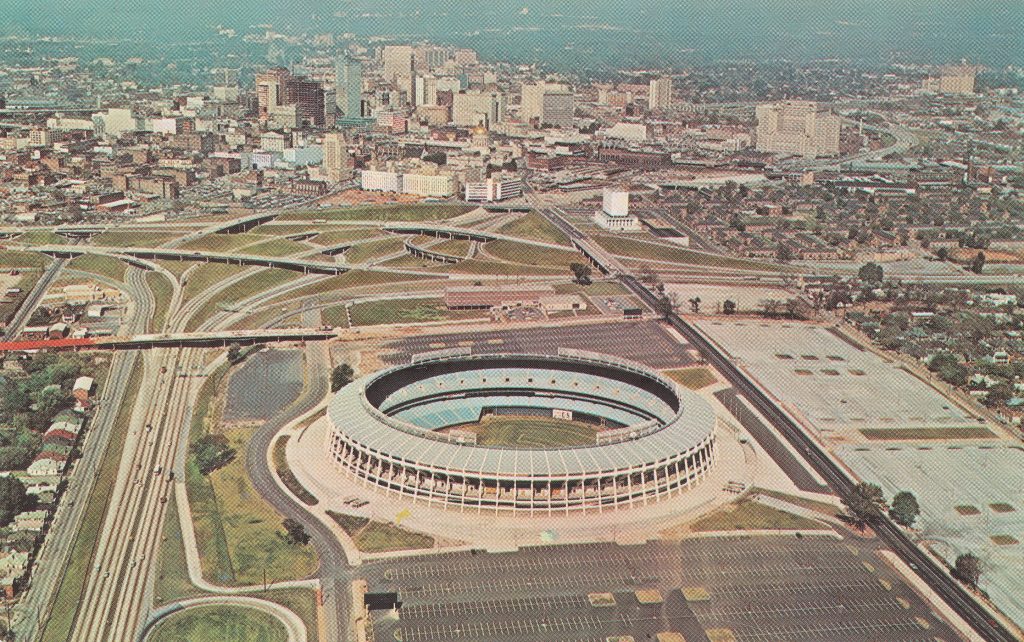Daniel Hennelly
Cookie Cutter Stadiums
Part I
Until the early 1950s with a few exceptions, the sixteen major league baseball teams owned the stadium in which they played. The Phillies were tenants at Shibe Park, owned by the Philadelphia Athletics. The St. Louis Browns (now the Baltimore Orioles) owned Sportsman’s Park and shared it with the Cardinals, later selling it to them in 1953. The Indians (now the Guardians) had moved to Cleveland Municipal Stadium in 1947 from team owned League Park, after playing night, holiday, and Sunday games at Municipal Stadium since the late 1930s.
Many major league parks were over forty years old, had limited parking, and lacked fan amenities. Upkeep and operation of the stadiums were a major team expense.
Maintenance had been deferred during the Depression. Saint Louis had even threatened to condemn Sportsman’s Park. The Phillies moved to Shibe Park, home of the crosstown Athletics, in the middle of the 1938 season because they could not afford to repair the deteriorating Baker Bowl.
When the Boston Braves moved to Milwaukee in 1953, the Browns to Baltimore in 1954, the Athletics to Kansas City in 1955, the teams found municipal stadiums waiting for them. Lease arrangements were often lucrative for the team. Of the teams that relocated in the 1950s and 1960s, only the Dodgers, after moving from Brooklyn to Los Angeles in 1958, built their own ballpark.
Major league baseball had a new business model of municipal governments shouldering the cost of building, maintaining, and operating their ballparks. National Football League teams utilized many baseball stadiums and wanted no part in building and operating a stadium since they only played several home games each season. Municipal governments were requested to build stadiums to host two sports teams with different field requirements. The solution was the multi-purpose “cookie cutter” stadium, called that because of their circular shape and look alike appearance.
Criticism began after the stadiums opened. Having to accommodate the larger field required for football, baseball fans often complained about poor sight lines. Even though cookie cutter stadiums featured movable seating to convert the stadium from baseball to football, much of the baseball seating was in the mezzanine and upper decks. The larger field dimensions favored pitching over hitting, changing the tempo of the game. Football fans were also unhappy since much of the seating was situated away from the action on the gridiron.

The first cookie-cutter stadium built was District of Columbia Stadium, later renamed for Senator Robert F. Kennedy after his assassination in 1968. During the 1920s and 1930s, a national stadium seating 100,000 spectators was proposed for Washington, DC to attract the Olympics as well as hosting events such as the annual Army-Navy football game. The only stadium in Washington, Griffith Stadium home of the Senators and Redskins, seated less than 30,000.
Plans to build a stadium stalled due to World War II although land was purchased along East Capitol Street to align the stadium with the Capitol Building and Washington Monument. In 1958, Congress approved funding for a smaller 50,000 seat stadium for the Redskins and Senators and construction began in 1960.
Calvin Griffith, the owner of the Senators, was unhappy with the stadium plan since he would lose the revenue from parking and concessions and moved the Senators to Minnesota renaming them the Twins. Washington was granted one of the two 1961 American League expansion teams and the team adopted the Senators moniker.
The Redskins played their first game in DC Stadium in October 1961 and President John F. Kennedy threw out the first pitch on April 9, 1962, to open the Senators season. Fans were initially happy since the stadium provided wider, comfortable seats, no obstructing pillars, 12,000 parking spaces, and improved lighting for night games. A unique design feature of the stadium is the curved, dipping roof that hides the lights because the stadium is the sightline of the Capitol Building.
The expansion Senators played in RFK Stadium through 1971 and moved to Texas in 1972, becoming the Rangers. The Redskins (now the Guardians) played in RFK through the 1996 season, moving to a new stadium in Landover, Maryland that seated over 80,000 fans. Baseball returned to RFK when the National League Montreal Expos relocated to Washington in 2005 and became the Nationals. The Nats played at RFK through 2007 while a new ballpark was constructed. RFK is slated to be demolished.

Shea Stadium, the home of the New York Mets, was the next cookie-cutter stadium constructed. It opened in 1964 to coincide with the 1964 – 1965 World’s Fair held next door in Flushing Meadows – Corona Park. Until 1980, the stadium’s exterior featured orange and blue rectangular panels, the Met’s official colors (blue from the Brooklyn Dodgers and orange from the New York Giants.) It was the home of the NFL New York Jets until 1983 and the New York Giants for the 1975 season.
Robert Moses, New York’s master builder and political fixer, originally offered the site to Walter O’Malley, the owner of the Brooklyn Dodgers, who sought to replace crumbling Ebbets Field in the 1950s. The Dodgers wanted to build a domed stadium in downtown Brooklyn where the Barclay’s Center now sits. Moses refused to give approval for a stadium in downtown Brooklyn. O’Malley rejected Moses’ offer, telling Moses that if he moved to Queens, his team would no longer be the Brooklyn Dodgers. Instead, O’Malley moved the Dodgers to Los Angeles and built Dodger Stadium.
Conceptual drawings for Shea Stadium showed the outfield enclosed with seating for 90,000 fans. When the stadium was built, no outfield seating was constructed, instead a large scoreboard was erected instead. That proved to be a serious design flaw. Located on Flushing Bay, winds often whipped into Shea, chilling fans to their bones.
Shea Stadium had a seating capacity of 55,000. While Yankee Stadium was being renovated in 1974 – 1975, the Mets unwillingly shared Shea with the New York Yankees for the two seasons. The Mets played their last game at Shea on September 18, 2008, and the following season moved to Citi Field built next door. Shea Stadium’s demolition was completed in 2010.

Houston had been awarded an expansion team by the National League in 1962. Known as the Colt .45s, the team played in a temporary stadium for its first two seasons. Houston’s subtropical climate had temperatures above 95 degrees with high humidity during the summer, making games miserable for fans and players. Summer rainstorms threatened to wreak havoc with the team’s baseball schedule. The team-owner, Roy Hofheinz, promised the National League to build a domed stadium, drawing inspiration from antiquity’s Roman Colosseum and its retractable awning.
The Harris County Domed Stadium, known as the Astrodome, opened during the 1965 baseball season. It was the world’s first enclosed, air-conditioned stadium. After the relocation of the Manned Space Center to Houston (now the Johnson Space Center), the team changed its name to the Astros. Hofheinz billed the Astrodome as the Eighth Wonder of the World.
A feat of 20th century engineering, the Astrodome stood eighteen stories high and covered 9.5 acres. Its air conditioning system was designed to move 2,500,000 feet of air a minute and circulate in fresh air to limit the buildup of carbon dioxide and cigarette smoke. The scoreboard was the first animated scoreboard and cost over two million dollars.
Glare from the dome’s glass panels caused fielders to lose track of balls. To solve the problem, the panels were painted over and the grass playing field died. A newly invented artificial playing surface popularly known as Astroturf was installed to the dismay of baseball purists. Astroturf sped ground balls through the infield and sometimes caused the ball to bounce over the heads of fielders. Like all cookie cutter stadiums, the large field dimensions to accommodate football, favored pitchers over batters.
The Eighth Wonder of the World did not age well. In 1997, the NFL Houston Oilers departed to Tennessee followed by the Astros move to Minute Maid Park in 2000. In comparison, the Roman Colosseum hosted gladiatorial contests for four centuries until the Catholic Church ended the games. The Astrodome has sat empty for over two decades.

In the early 1960s, Atlanta civic leaders saw attracting a major league baseball or football team as key to proclaiming Atlanta as the capital of the New South. A 47-acre site near the state capital that had been leveled in an urban renewal project, was selected as the site for the stadium. Atlanta – Fulton County Stadium was completed in April 1965 and the Milwaukee Braves moved to Atlanta in 1966. The expansion NFL Falcons also started play that year. Like the other cookie cutter stadiums its generous field dimensions should have made it a pitcher’s ballpark. Instead, due to Atlanta sitting 1,050 feet above sea level, batted balls flew out of the ballpark due to the thinner air. Hank Aaron changed his batting stance and became a pull hitter to take advantage of the phenomena. Aaron hit the 715th home run of his career in April 1974 in the stadium to break Babe Ruth’s career record.
The Atlanta Falcons moved to the Georgia Dome in 1992. In 1996, the stadium hosted the baseball competition for the 1996 Olympics held in Atlanta. The Braves moved to Turner Field that had been constructed for the Olympics and modified for baseball after the end of the games. They moved to Truist Park in suburban Cobb County in 2017. Atlanta-Fulton County Stadium was imploded in August 1997.
***
[Editor’s note: The history of Cookie Cutter Stadiums will pause here until next week in the same time-slot – Tuesday. Part II will continue in Saint Louis with a look at Busch Memorial Stadium and its service as the home of the National League’s Cardinals from 1966 until 2005.]
Great history. I remember all those cookie-cutter stadiums seemed to be built around the same time. The lower field stands would rotate for football. It was a great idea. Unfortunately, the lower stands were too low for football (you’d be blocked from seeing the field by team personnel standing on the sidelines), and for baseball, the stands faced 2d base or the outfield rather than the pitcher or batter. I recall going to Shea Stadium on opening day 1966. The Mets won, but it was a cold day in April. My friend and I bought cocoa in a futile effort… Read more »
I went to a game in Shea Stadium on a Saturday night in June 1966, the Mets versus the Reds. We froze to death, I thought it was the middle of winter.
Veterans Stadium in Philadelphia was one of those cookie cutter stadiums. Very impersonal and ugly, I thought it was.
The Vet will be in Part 2.
Regarding the Mets colors of blue and orange, from the Dodgers and Giants respectively, these are the official colors of the flag of New York City (along with white), and have been so since the early twentieth century at least. Likewise, blue and orange are the colors of the city’s public schools. So I like to think the New York Metropolitans got their colors directly from their home city itself.
Looking forward to Part 2!
While the Cleveland Indians did change their name to Guardians, the Redskins became the Commanders after a brief stint as the unimaginatively-labeled Washington Football Team.